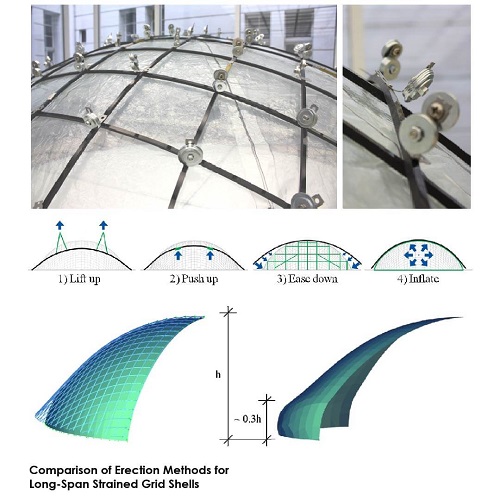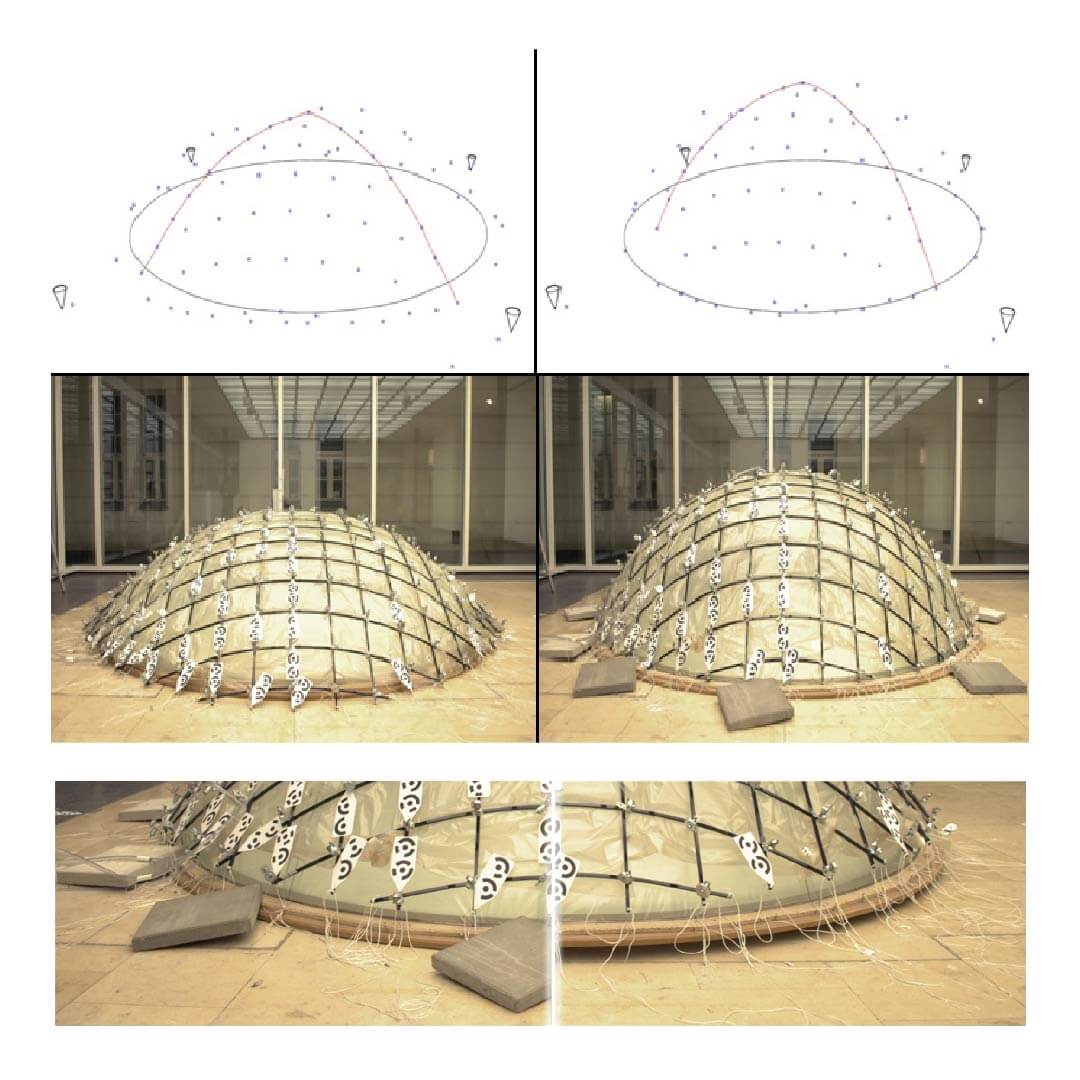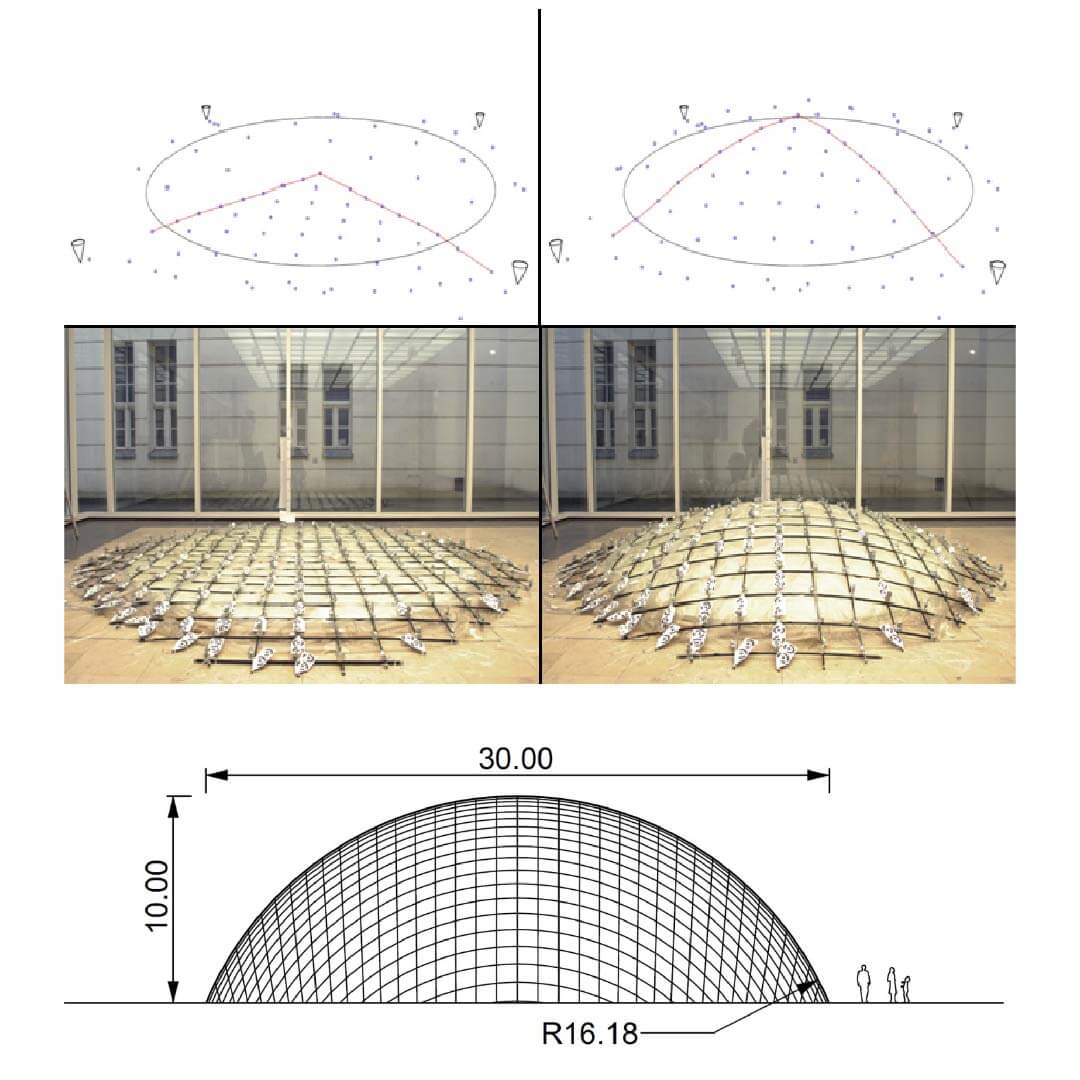
String Art Generator
String Art Generator by Yiran is a grasshopper plugin which generates a string art sequence based on an input image. You can

Comparison of Erection Methods for Long-Span Strained Grid Shells
In this paper, a detailed comparison is carried out between established (‘lift up’, ‘push up’ and ‘ease down’) as well as novel (‘inflate’) erection methods for strained grid shells by means of FE simulations and a 3D-scanned scaled physical model in order to evaluate key performance criteria such as bending stresses during erection and the distance between shell nodes and their spatial target geometry.
These investigations were carried out on a case study of a dome with a 30m span, 10m pitch and constant double curvature. A detailed description is provided of the developed simulation approach, which makes particular use of contact springs for a structural system subject to large deformations, in the SOFiSTiK FE software environment.
 It is shown for the ‘lift up’ and ‘push up’ methods, that maximum bending stresses are most likely to occur during the erection process and not during end-state static load cases.
It is shown for the ‘lift up’ and ‘push up’ methods, that maximum bending stresses are most likely to occur during the erection process and not during end-state static load cases.
This risk of beam-overstressing for existing erection methods along with challenges caused by modern safety restrictions, scaffolding costs and build duration can be drastically reduced or even eliminated by making use of inflated pneumatic cushions for the erection of strained grid shells.
 Furthermore it is argued that the use of pneumatic falsework has the potential to once again facilitate large-span strained grid shell structures such as have not been realised since the likes of the extraordinary “Multihalle Mannheim”.
Furthermore it is argued that the use of pneumatic falsework has the potential to once again facilitate large-span strained grid shell structures such as have not been realised since the likes of the extraordinary “Multihalle Mannheim”.
It is claimed that the overriding constructional benefits of strained grid shells, such as low material usage and fabrication simplicity, are undermined by the methods typically used for their erection.
 In this paper reference is made to ‘strained’ grid shells, while in literature the term ‘elastic’ grid shells is also used often. While both are valid and interchangeable terms, the high probability of creep relaxation after erection means that the amount of elastic recovery can be very limited and subsequently ‘strained’ is deemed a more accurate engineering description for the behaviour.
In this paper reference is made to ‘strained’ grid shells, while in literature the term ‘elastic’ grid shells is also used often. While both are valid and interchangeable terms, the high probability of creep relaxation after erection means that the amount of elastic recovery can be very limited and subsequently ‘strained’ is deemed a more accurate engineering description for the behaviour.
 There are three tried and tested ways to erect a strained grid shell: ‘lift up’, ‘push up’ & ‘ease down’. The practicality of each method and the effect on structural behaviour varies. While the benefits and caveats of each erection method have been compared qualitatively, so far no quantitative comparison of the erection methods exists.
There are three tried and tested ways to erect a strained grid shell: ‘lift up’, ‘push up’ & ‘ease down’. The practicality of each method and the effect on structural behaviour varies. While the benefits and caveats of each erection method have been compared qualitatively, so far no quantitative comparison of the erection methods exists.
This paper provides a detailed write-up of a series of finite element simulations developed in order to compare said established erection methods. Although the idea of pneumatic falsework for the erection of strained grid shells (‘inflate’) has been considered before, the work presented in this paper presents the first ever practical experiment of the proposed method.

String Art Generator by Yiran is a grasshopper plugin which generates a string art sequence based on an input image. You can

This paper by Alessandro Liuti, Sofia Colabella, and Alberto Pugnale, presents the construction of Airshell, a small timber gridshell prototype erected by employing a pneumatic formwork.

In this paper by Gregory Charles Quinn, Chris J K Williams, and Christoph Gengnagel, a detailed comparison is carried out between established as well as novel erection methods for strained grid shells by means of FE simulations and a 3D-scanned scaled physical model in order to evaluate key performance criteria such as bending stresses during erection and the distance between shell nodes and their spatial target geometry.

In this paper by Frederic Tayeb, Olivier Baverel, Jean-François Caron, Lionel du Peloux, ductility aspects of a light-weight composite gridshell are developed.
Parametric Ideas for Architects @2025
This tutorial or example file is exclusive to Paracourse Members.
Paracourse is an extensive library of video tutorials and example files, designed to guide you through your parametric design journey. With over 1,500 open example files & 600 Video Tutorials, you can freely edit and adapt them for your projects—no credit required.

Learn parametric design from scratch with over 100 hours of step-by-step tutorials, covering beginner to intermediate levels. Master components and their use in the design process.

Explore our open-to-edit .gh files to see how each subject is designed parametrically using Grasshopper3D. Freely adapt them for your projects—no credit required.

Delve into complete algorithms with our advanced tutorials. Learn the logic behind each step, understand how the parts work together, and see how to apply them effectively in your designs.
Grasshopper empowers architects and designers to create sophisticated, customizable designs with ease.
Architects, industrial designers, artists, and anyone passionate about parametric design will find value in this course.
With diverse tutorials and open example files, you’ll have everything you need to tackle any design challenge.
Mastering Grasshopper with Paracourse can significantly enhance your career prospects.